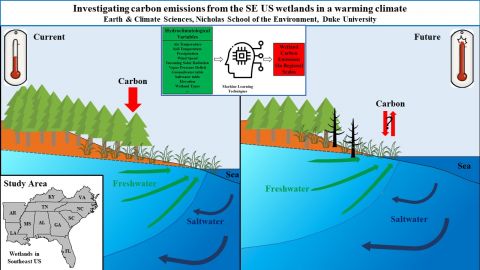A team of students led by researchers in the Hydroclimatological Lab created a workflow/pipeline for comprehensively estimating the carbon emissions from the Southeastern (SE) United States (US) wetlands using machine learning techniques applied to multi-source data, including field measurements, remote sensing products, and biophysical model outputs. The team first applied machine learning (ML) techniques to establish the relationships between environmental variables and wetland carbon fluxes measured by AmeriFlux and/or modeled by the biophysical model, Forest-DNDC. Then, a workflow/pipeline was created to integrate data ingestion, feature engineering, trained ML model deployment, and output postprocessing to more effectively estimate wetland carbon emission on a regional scale, e.g., the entire SE US. This Data+ project will not only allow us to better understand how the wetland carbon cycle responds to climate change but also lay the foundation for the Bass Connections team to further generate monthly fine-gridded data products of historical and future CO2 fluxes from wetlands in the SE US to inform whether/where/when the wetlands have been/will be converted from net carbon sinks to sources.
Project Lead: Wenhong Li
Project Manager: Keqi He
View the team’s project poster here: Team 21 Final Poster
View the team’s video presentation here:









